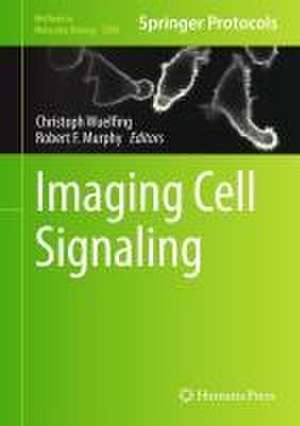Imaging Cell Signaling: Methods in Molecular Biology, cartea 2800
Editat de Christoph Wuelfing, Robert F. Murphyen Limba Engleză Hardback – 7 mai 2024
Cutting-edge and authoritative, Imaging Cell Signaling is a valuable resource that provides guidance to researchers looking to learn how to effectively tailor design projects to image, manipulate, and model signal transduction.
Din seria Methods in Molecular Biology
- 9%
 Preț: 791.59 lei
Preț: 791.59 lei - 23%
 Preț: 598.56 lei
Preț: 598.56 lei - 20%
 Preț: 882.95 lei
Preț: 882.95 lei -
 Preț: 252.04 lei
Preț: 252.04 lei - 5%
 Preț: 802.69 lei
Preț: 802.69 lei - 5%
 Preț: 729.61 lei
Preț: 729.61 lei - 5%
 Preț: 731.43 lei
Preț: 731.43 lei - 5%
 Preț: 741.30 lei
Preț: 741.30 lei - 5%
 Preț: 747.16 lei
Preț: 747.16 lei - 15%
 Preț: 663.45 lei
Preț: 663.45 lei - 18%
 Preț: 1025.34 lei
Preț: 1025.34 lei - 5%
 Preț: 734.57 lei
Preț: 734.57 lei - 18%
 Preț: 914.20 lei
Preț: 914.20 lei - 15%
 Preț: 664.61 lei
Preț: 664.61 lei - 15%
 Preț: 654.12 lei
Preț: 654.12 lei - 18%
 Preț: 1414.74 lei
Preț: 1414.74 lei - 5%
 Preț: 742.60 lei
Preț: 742.60 lei - 20%
 Preț: 821.63 lei
Preț: 821.63 lei - 18%
 Preț: 972.30 lei
Preț: 972.30 lei - 15%
 Preț: 660.49 lei
Preț: 660.49 lei - 5%
 Preț: 738.41 lei
Preț: 738.41 lei - 18%
 Preț: 984.92 lei
Preț: 984.92 lei - 5%
 Preț: 733.29 lei
Preț: 733.29 lei -
 Preț: 392.58 lei
Preț: 392.58 lei - 5%
 Preț: 746.26 lei
Preț: 746.26 lei - 18%
 Preț: 962.66 lei
Preț: 962.66 lei - 23%
 Preț: 860.21 lei
Preț: 860.21 lei - 15%
 Preț: 652.64 lei
Preț: 652.64 lei - 5%
 Preț: 1055.50 lei
Preț: 1055.50 lei - 23%
 Preț: 883.85 lei
Preț: 883.85 lei - 19%
 Preț: 491.88 lei
Preț: 491.88 lei - 5%
 Preț: 1038.84 lei
Preț: 1038.84 lei - 5%
 Preț: 524.15 lei
Preț: 524.15 lei - 18%
 Preț: 2122.34 lei
Preț: 2122.34 lei - 5%
 Preț: 1299.23 lei
Preț: 1299.23 lei - 5%
 Preț: 1339.10 lei
Preț: 1339.10 lei - 18%
 Preț: 1390.26 lei
Preț: 1390.26 lei - 18%
 Preț: 1395.63 lei
Preț: 1395.63 lei - 18%
 Preț: 1129.65 lei
Preț: 1129.65 lei - 18%
 Preț: 1408.26 lei
Preț: 1408.26 lei - 18%
 Preț: 1124.92 lei
Preț: 1124.92 lei - 18%
 Preț: 966.27 lei
Preț: 966.27 lei - 5%
 Preț: 1299.99 lei
Preț: 1299.99 lei - 5%
 Preț: 1108.51 lei
Preț: 1108.51 lei - 5%
 Preț: 983.72 lei
Preț: 983.72 lei - 5%
 Preț: 728.16 lei
Preț: 728.16 lei - 18%
 Preț: 1118.62 lei
Preț: 1118.62 lei - 18%
 Preț: 955.25 lei
Preț: 955.25 lei - 5%
 Preț: 1035.60 lei
Preț: 1035.60 lei - 18%
 Preț: 1400.35 lei
Preț: 1400.35 lei
Preț: 1225.48 lei
Preț vechi: 1494.49 lei
-18% Nou
Puncte Express: 1838
Preț estimativ în valută:
234.53€ • 242.99$ • 195.73£
234.53€ • 242.99$ • 195.73£
Carte tipărită la comandă
Livrare economică 22 martie-05 aprilie
Preluare comenzi: 021 569.72.76
Specificații
ISBN-13: 9781071638330
ISBN-10: 1071638335
Ilustrații: XI, 246 p. 76 illus., 73 illus. in color.
Dimensiuni: 178 x 254 mm
Greutate: 0.67 kg
Ediția:2024
Editura: Springer Us
Colecția Humana
Seria Methods in Molecular Biology
Locul publicării:New York, NY, United States
ISBN-10: 1071638335
Ilustrații: XI, 246 p. 76 illus., 73 illus. in color.
Dimensiuni: 178 x 254 mm
Greutate: 0.67 kg
Ediția:2024
Editura: Springer Us
Colecția Humana
Seria Methods in Molecular Biology
Locul publicării:New York, NY, United States
Cuprins
Rapid Preparation of Living Drosophila Pupal Macrophages for Ex Vivo Imaging.- Generation of 3D Fibroblast-Derived Extracellular Matrix and Analysis of Tumor Cell-Matrix Interactions and Signalling.- Induced Formation of Plasma Membrane Protrusions with Porous Materials as Instructive Surfaces.- Design and Synthesis of DNA Origami Nanostructures to Control TNF Receptor Activation.- Controlling the Potency of T Cell Activation using an Optically Tuneable Chimeric Antigen Receptor.- Imaging Cell Signaling in Tissues using the IBEX Method.- Investigating Epidermal Growth Factor Receptor Trafficking with High-Resolution Enzymatic Protein-Tagging and Transmission Electron Microscopy.- Some Guiding Principles for a "Simple" Correlative Light Electron Microscopy Experiment.- In Situ Imaging of Proteins using DNA-PAINT Super-Resolution Microscopy.- A Magnetic Pincher for the Dynamic Measurement of the Actin Cortex Thickness in Live Cells.- Measurement of Forces Acting on Single T Cell Receptors.- A Pipeline for Dynamic Analysis of Mitochondrial Content in Developing T Cells: Bridging the Gap between High Throughput Flow Cytometry and Single-Cell Microscopy Analysis.- Reconstructing Signaling Networks using Biosensor Barcoding.- Deep Learning-Based Cell Tracking in Deforming Organs and Moving Animals.- Using Dimensionality Reduction to Visualize Phenotypic Changes in High-Throughput Microscopy.- Learning Morphological, Spatial, and Dynamic Models for Cellular Components.
Textul de pe ultima copertă
This volume explores recent innovations across the entire pipeline of imaging signal transduction, cell preparation, cellular manipulation, image acquisition, and computational analysis. The chapters in this book cover topics such as rapid preparation of living Drosophila pupal macrophages for ex vivo imaging; controlling the potency of T cell activation using an optically tuneable chimeric antigen receptor; in situ imaging of proteins using DNA-PAINT super-resolution microscopy; reconstructing signaling networks using biosensor barcoding; and morphological, spatial, and dynamic models for cellular components. Written in the highly successful Methods in Molecular Biology series format, chapters include introductions to their respective topics, lists of the necessary materials and reagents, step-by-step, readily reproducible laboratory protocols, and tips on troubleshooting and avoiding known pitfalls.
Cutting-edge and authoritative, Imaging Cell Signaling is a valuable resource that provides guidance to researchers looking to learn how to effectively tailor design projects to image, manipulate, and model signal transduction.
Cutting-edge and authoritative, Imaging Cell Signaling is a valuable resource that provides guidance to researchers looking to learn how to effectively tailor design projects to image, manipulate, and model signal transduction.
Caracteristici
Includes cutting-edge methods and protocols Provides step-by-step detail essential for reproducible results Contains key notes and implementation advice from the experts
